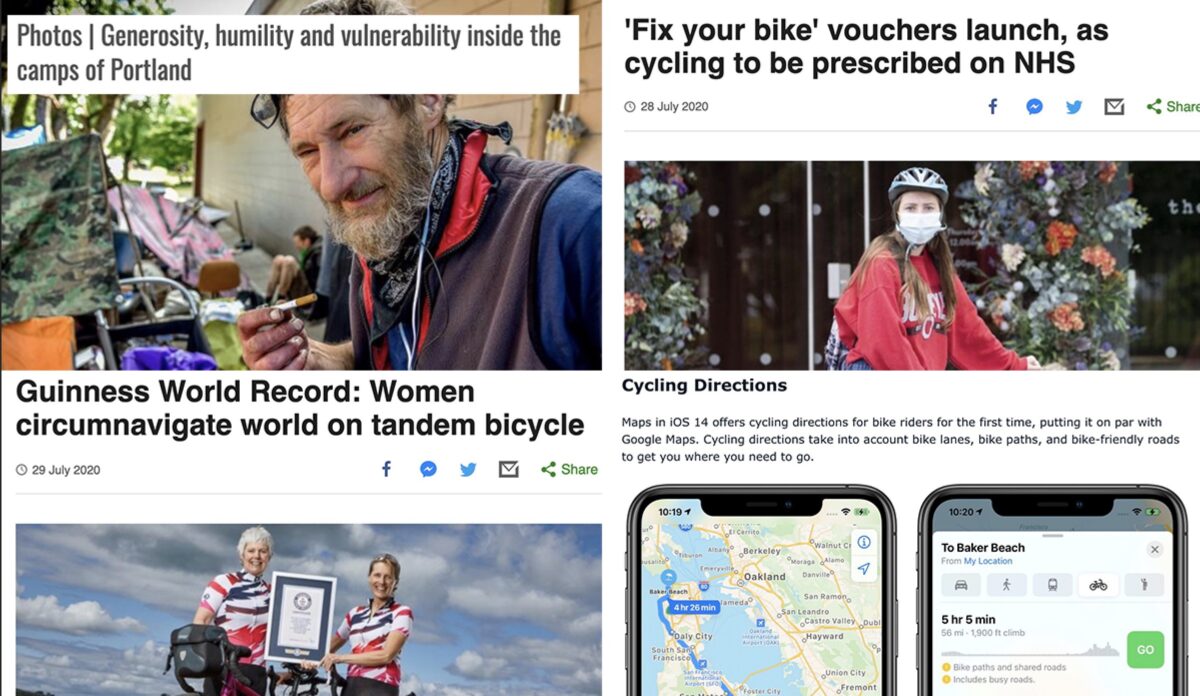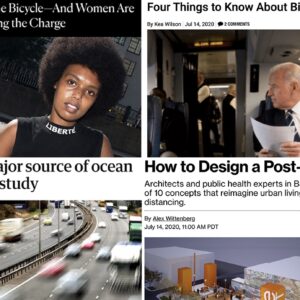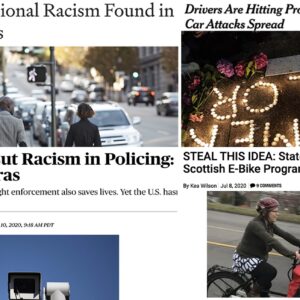Thanks for your understanding while I was away last week. I’m excited to be back at it and have lots of stories and content to share.
Here are the most noteworthy items we came across in the past seven days (thanks everyone for sending in link suggestions!)…
Bike repair subsidies: The British government has prescribed cycling as a Covid-19 prevention measure and they’ve backed that up with a bike repair voucher plan.
Go ahead and ride: New research says riding public transit is relatively safe and that major systems across the U.S. have not spread coronavirus among riders.
E-Cars won’t save us: “We will not be able to electrify all of our transportation in the timeframe necessary to deal with climate change,” says The Conversation’s Beth Daley, who points to a shortage in battery materials and high carbon footprint of EVs.
Inside the camps: Street Roots sent a photographer into several large outdoor camps you’ve probably ridden by dozens of times and talked to people who live in them — including one many who’s the resident bike mechanic.
Kool Stop founder dies: Richard Everett, the man who founded a Lake Oswego-based company that had major success making bicycle brake pads, has died at age 75.
Advertisement
Women rule: Two women have smashed the around-the-world record for tandem riding by pedaling 18,263 miles in 263 days through 25 countries — and they did it 18 days faster than the previous record (which was held by two men).
Inclusive cycling and the pandemic: The BBC has a good overview of how the coronavirus pandemic has impacted cycle planning and why now is a great opportunity to make bike riding more inclusive.
Go By Bike: Apple’s latest iOS release features cycling-specific routes and directions, but it’s limited to just a few cities (not including Portland) and it seems to be off to a rough start.
Walk to bike: Not to be outdone by Apple, Google has improved its Maps service by providing custom, dock-to-dock directions for bike share users in a limited amount of cities. Hopefully this expands to Portland by September when our new Biketown hits the streets.
Bike boom worldwide: The Wall St. Journal takes a deep dive into how cities around the world have quickly implemented bikeways in response to Covid-19.
— Jonathan Maus: (503) 706-8804, @jonathan_maus on Twitter and jonathan@bikeportland.org
— Get our headlines delivered to your inbox.
— Support this independent community media outlet with a one-time contribution or monthly subscription.








Thanks for reading.
BikePortland has served this community with independent community journalism since 2005. We rely on subscriptions from readers like you to survive. Your financial support is vital in keeping this valuable resource alive and well.
Please subscribe today to strengthen and expand our work.
Been a big Kool Stop fan since I discovered them several years ago, specifically the salmon (wet-weather) pads. Whenever anyone mentions to me that they have trouble stopping, whether it’s in certain conditions or just that they wish it was faster, the first thing I recommend after checking proper brake alignment/setup is to try Kool Stop pads.
R.I.P.
Those salmon pads were great and I used a lot of them until I started using disc brakes which work much better than any rim brake in the wet (and dry).
I agree that (excluding some fringe exceptions) discs are generally superior in all conditions. I’ve only had discs on a mtb I had for a few years, which makes it difficult to compare since that bike was nearly double the weight of my road bike, but even for a low-end model the hydraulic brakes worked well for stopping – avoiding pad/rotor rub, not so much.
I recently got a new road frame (DengFu R06, really liking it so far!) and I went with direct-mount rim brakes, simply because I already had nearly all the parts to build it up from a previous bike where I had only sold the frame. If I was going to get a new complete bike I probably would have gone discs, but when building up it’s much cheaper to stick with what you already have, including the cost of additional tools since I like to wrench myself. I got the specific frame I did based mostly on the brake type, actually. The direct-mount brakes, while still not the level of good discs, are a noticeable improvement over single-bolt calipers, and easier to setup and maintain as well. Wish there were more frames available with them, but as they came out relatively recently they’ve been (understandably) overlooked in favor of discs, and so also tend to only be found on higher-end bikes (got mine originally to go on an SWorks Tarmac SL6). For those not yet sold on discs on the road they make a good very good option for improved braking – especially with Kool Stop pads! 😉
The “off to a rough start” article in the section about Apple Maps bike directions is really misleading. It is based on a single screenshot from the June keynote. If the writer was actually concerned about the quality of the bike directions they could have installed the public beta and tested the bike directions feature first hand. It’s possible that the directions aren’t good (which wouldn’t be a huge surprise in the 1st version of a feature that’s still in beta), but it’s disingenuous to judge a feature based on one route from a screenshot.
Vis a vis, Go By Bike and Walk to Bike / Google maps; they are both outdone by a little app called Komoot. I have a commute from the Kerns neighborhood to Lake Oswego. After a lot of refinements, I was able to trim this down to 11.4 miles and only 800′ elevation gain. It took me a lot of searching on Google maps. Not until I noticed a pedestrian bridge over I-5 did I make the biggest reduction in miles.
Several months after doing the final route, I learned about Komoot. I plugged in the destination and start point for my commute and it chose the exact route that I had discovered. I was pretty impressed since Google maps, by default, shows a 14.9 mile route. The route takes you through the cemetery as well, which isn’t open during the wee hours of the morning.
Are you willing to share the pedestrian bridge? Now we know to look for it, but a little help would be sweet. Must pre-date BP…
I used it for a while, but now I just go up to Capitol Hwy. Just a bit past and turn left next to McDonald’s. The ped bridge is in the back of the bus depot on Barbur.
I find that the traffic headed out of town on Barbur in the AM is mellow enough, I don’t have to fight to get where I need to be in the lane. So, I am comfortable doing the wacka-do left turn just past Capitol Hwy.
Here is the link: https://goo.gl/maps/BByGWLsRfJaKh61KA
Armed with your personal data, Google will always have a head start (and likely keep the lead) over Apple Maps, Siri, et al. If I think the trade is worth it, I can also understand why not everyone wants to spill that much tea to a company that largely profits at the expense of your privacy.
The reason there are minimal Covid-19 cases from transit ridership, it comes down to one thing, the masks. Riders have no misconceptions about who else is on the train with them so they wear masks. It is becoming clear that the biggest source of Covid-19 infections is cool, dry, indoor spaces filled with unmasked folks.The worst thing right now is indoor dining, church services,food processing plants and weddings.It is far better to take the train to an outdoor protest rally than to take your personal car to a relatives indoor wedding.
Add house parties and gyms. I still can’t believe that indoor gyms are open right now.
Well that and, at least in PDX, ridership is way down. No one rides the bus, no one gets sick on the bus. I don’t know what ridership is like in other parts of the world though, so it could be non-causative correlation.
Ridership is down, but as I understand it ridership relative to transit vehicle capacity is not down very much. With social distancing, buses have far less effective capacity right now. Here in the Twin Cities, Metro Transit has shifted some routes to using larger buses the handle the “crowds”. Obviously this is not cost-sustainable in the long run, but “no one rides the bus” is VERY far from the case. My understanding (correct me if I’m wrong) is this is also true on TriMet.
It’s been a nose dive. https://trimet.org/about/performance.htm#weekly
I would have posted something like this in my original comment, but I didn’t believe the claim would be challenged.
Why shouldn’t low-mileage liberals spend their cash on new EVs? The reason to rule them all: that’s hogging scarce materials which could be used to convert high mileage vehicles in constant use for transit and material transport. Maintain your beater and drive a lot less. Sell it and go by foot. Take three weeks off and bike there. (Less income, less consumption, less embodied energy). Beat your city government around the head and shoulders, metaphorically, until they the produce the transit or bike infrastructure that will make you happy. Do not command the economy to extract a thousand kilos of stuff from the planet, move it thousands of kilometers, smelt it, weld it, prettify it, etc, so you can go get some ramen.
Thank you, X.
I was hoping someone would respond to the lithium article.
So not helpful, X. Yes, we need better transit and better bike facilities. And, under any scenario I’ve ever seen analyzed, there will still be millions/billions of cars for the next few decades. If they aren’t all electric, and soon, there’s no hope of addressing climate change. So yes – electrifying cars, buses, trucks that travel a lot is better than those that don’t travel as much. Driving less is even better. But we also need to increase the scale of EV sales to drive down costs and increase efficiency – just like we did with solar. I seldom heard folks say “you solar advocates are sellouts, everyone should just turn down the heat and cook less.” Energy efficiency is great, AND we need what’s used to be renewable. Same thing with transportation.
Straw man detected. Your comment about solar advocates being sellouts is not relevant to what X said.
I think the straw person is x’s claim that ev buyers are all ramen eating signaling yuppies who don’t drive much. Generalize much? I for one really don’t like ramen and the used e golf I bought for $11k gets more use than our gas car… and less than our bikes do…
Maybe X’s not talking about you specifically. X definitely didn’t mention yuppies. That was you.
I stereotyped a bit, yes, in the interest of being brief. Another time I’ll go into the weeds, split hairs, digress and circumlocute. That’s my jam.
Embodied energy is energy. Bringing an extra thousand kilos of stuff with you everywhere you go? Buying newly manufactured stuff as the fix for all problems? I identify those behaviors as part of our problem.
The article assumes the battery technology in today’s EV’s, which due to the automotive industry’s slow pace of adoption is actually decade old battery technology, will continue to be the same battery technology going forward for the next 35 years! That’s an incredible assumption to make, one which essentially makes this article’s argument DOA.
Already, everyone is working on reducing various hard to source metals and considerable success has been achieved. There’s no reason to believe this will stop. In fact, it should accelerate but the entire argument could be pointless when solid state batteries change all of this in an instant.
Arguments against EV’s are not only dumb but also narrowly focused. If you’re arguing against cars in general then why not use the vast savings in avoiding transportation infrastructure development currently underway or planned in your argument instead of “tires cause particles”???
I’m sure most readers are already aware of where I stand on many issues. Of course, our biosphere is of utmost importance and should be prioritized accordingly, but there’s no need to turn luddite as a form of penance for prior generation’s transgressions. We have the technology to carry civilization forward in a sustainable way. The only barrier to this is an entrenched oligarchy bent on profiting to the last drop from last century’s fuel source, oil!
I think we should:
-make intelligent use of stuff that exists
-tax industries and activities that produce externalities, public costs not otherwise paid for.
-identify needed services that aren’t widely available in the market and subsidize them.
In the area of transportation people use private cars because they are relatively cheap and give at least the illusion of free movement, externalities be damned. I would tax fuel at a rate known to reduce driving in the short run with predictable increases at an accelerating rate. The yield from that tax would be used to make transit a viable travel option that would enable human activities not now possible.
There are a lot of reasons why transit fails. Misuse of roads for storing private cars would be one.
Inside the camps: Great article, excellent photos. When I lived in Portland (1997-2015), the homeless camps would grow and ebb mostly based on economics, but they were always there, either hidden or out in the open. For example, during the Great Recession of 2008-12, they actually shrank somewhat (or were maybe suppressed more), while they grew rapidly just before I left in 2015 as rents were going through the roof, which is primarily why I left. After a while one becomes desensitized to the issue and the misery, the more one encounters it on an everyday basis – I’d see at least a dozen people sleeping at business entryways every day on my walk to work from Goose Hollow to PBOT in the early 2000s. But one of the people quoted is quite correct, the rest of us who have a roof over our heads have a real fear that we could be next, one disaster away from homelessness ourselves. While many of the Portland camps shown are new to me, the locations are very familiar to me from my rides throughout the city. And of course one sees much the same in any other large city going through rapid rent increases such as DC, Charlotte, etc.
Jeff Allen:
1. Thanks for having the guts to comment here under what I assume is your full real name. Refreshing!
2. I believe that you think climate change is real and you are earnestly seeking a solution.
3. Do you believe that everyone on the planet who desires automobility can have an EV? Am I reading something into your posts that isn’t there?
My understanding of the market economy is that every time a person buys a thing, somebody else gets busy and fills the blank spot on the shelf. In extreme cases they open a new store amd fill it with shelves, and things. If those things are electric they have batteries and the battery warehouse puts in an order amd somebody else digs a new rare earth mine. OK I skipped some steps but at this point only about two people are still with us.
Re: “Women rule…” These people are mid 50s! Good for them!